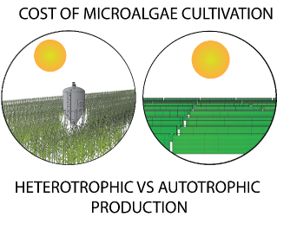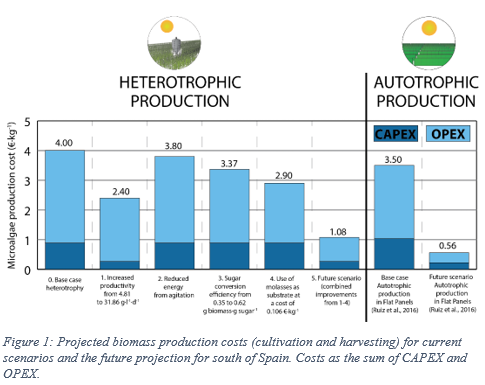HETEROTROPHIC VS AUTOTROPHIC PRODUCTION OF MICROALGAE: BRINGING SOME LIGHT INTO THE EVERLASTING COST CONTROVERSY
Introduction
Heterotrophic or autotrophic? This is the continuous question industry faces when microalgae production is the endeavor. Without a doubt, production cost may be among the reasons to come to a decision. Surprisingly, still today specialists have not reached a consensus on which is the most economical option.
To shed some light on the issue, the current work thoroughly analyses costs for heterotrophic and autotrophic cultivation of microalgae at industrial scale. Our work follows a similar procedure as the one we previously developed to explore costs of autotrophic production (Ruiz et al., 2016). These cost studies on heterotrophic and autotrophic production follow analogous methodologies, and they both share some of the fundamental points, such as location or biomass capacity. These facts indicate that a reliable comparison can be performed.
Methods
We developed a model to perform a Techno-economic assessment of microalgae production in fermenters under heterotrophic conditions. Biomass capacity of the projected facility is 6.094 ton·year-1 measured as dry weight. It is identical to the autotrophic production in our Article Towards industrial products from microalgae for Flat Panels in Spain (Ruiz et al., 2016), which enables comparisons.
Studied species: Chlorella sp. is used as cell factory. This is the most studied heterotrophic microalga and its performance exceeds most of other microalgae under these conditions. The cultivation is performed in batch process with a biomass productivity of 4.81 g·l-1·d-1 (this is an average from 23 tests on Chlorella sp. in glucose, which ranged between 31.86 and 0.15 g·l-1·d-1).
Results
After comparing the value from our heterotrophic base case (4.00 €·kg-1) and the base case of autotrophic production in flat panels (3.50 €·kg-1 (Ruiz et al., 2016)) we can sustain that heterotrophic carbon nutrition of microalgae is costlier (Figure 1). However, it depends on the production system, as our previous study also reveals that photosynthetic production in tubular photobioreactors or open ponds can reach a cost above 5.20 €·kg-1 (Ruiz et al., 2016). Thus, although we can claim that autotrophic culture in flat panels would be cheaper than heterotrophic production, the latter is not always the most expensive option.
Conclusions
The results show a comparable cost for heterotrophic and autotrophic production of microalgae at industrial scale. Nevertheless, although large-scale cultivation in fermenters and open ponds came true, existing facilities based on photobioreactors are still relatively small. Microalgae need a leap forward in production scale to become a competitive novel feedstock for biobased products. A facility producing thousands of tons of biomass per year could benefit from the economy of scale, overcoming most cost restraints.
References
Ruiz, J., Olivieri , G., de Vree, J., Bosma, R., Willems, P., Reith, J.H., Eppink , M.H.M., Kleinegris, D.M.M., Wijffels, R.H., Barbosa, M.J., 2016. Towards industrial products from microalgae. Energy Environ. Sci. 24, 405–413. https://doi.org/10.1039/C6EE01493C

